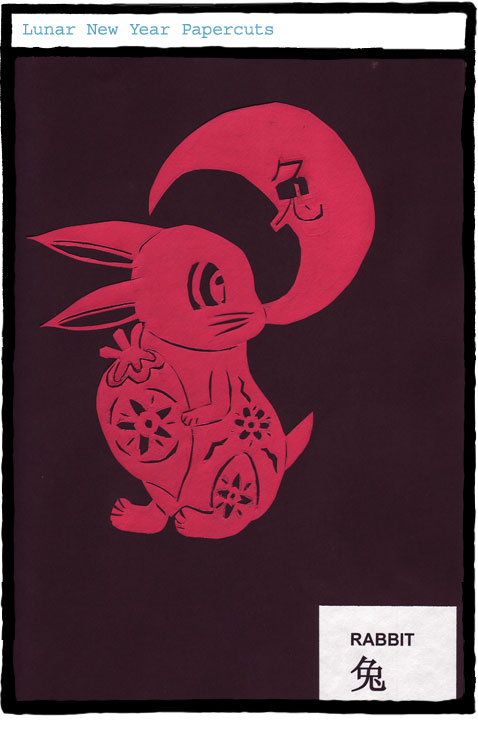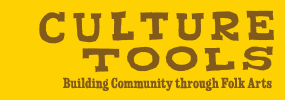Work by the Grade 7 Art Class at FACTS, 2008–09
Click a thumbnail to see it full size.
Download the Lesson Plan for Lunar New Year Papercuts.
Here are some things to think about:
Who is in your own gallery of valued cultural treasures?
From who have you learned? (And what?)
What do you value and want to pass on?
Where have you taken a stand?
Playing & Learning With Folk Arts

Lunar New Year Papercuts
Introduction
Different Kinds of Calendars. Lunar New Year is celebrated at FACTS, so regardless of family background or ethnicity, students develop some familiarity with the holiday. Start by using this as an opportunity to talk about and compare different calendars. Another exercise in building a sense of the relationships between universal practices (people count time) and specific practices (people count time in different ways, with different starting points and different units of measurement).
Ask: What is a year? What is a day? What is a month? Describe the material/physical world starting point: once around the axis / once around the sun / one cycle of a moon’s phases. Then explore implications, establishing that there are many different calendars: the calendar you know is one of many calendars of the year.
Ask: What are some different ways of counting? What year is it: 2009 (since what?) Name the Gregorian calendar as Christian, and only one of many ways of counting time. Examples: Islamic/ Muslim / Hijiri calendar: 1430 AH. Jewish calendar: 5769. (See http://www.interfaithcalendar.org/NewYears.htm for a list of Bahai, Christian, Hindu, Islamic, Jain, Jewish, Sikh and Zororastrian New Year dates).
New Year Celebrations
Move to a discussion of how the beginning of the year is celebrated.
Ask: What are practices that students know about that people do for New Years? Ask about what happens / what people do on January 1st: watch ball drop, eat special foods (black-eyed peas), shoot off firecrackers, gather with others.
Ask: What are some of the shared practices people have for Lunar New Year? What do you know? What do others do? (Wear special clothing, exchange red envelopes, clean, come together and spend time, honor family unit, prepare and eat special foods, noisemaking. Decoration of self with funny hats or special traditional costumes, decoration of house.)
Ask: Are there any shared symbols that are used: Baby New Year / Father Time. What do these symbols mean?
Lunar New Year Symbols
Explore who observes Lunar New Year celebrations. (At FACTS, there are many Asian New Years celebrated: Chinese, Vietnamese, Cambodian, and Lao. See http://en.wikipedia.org/wiki/Lunar_New_Year) Discuss what is shared and what is distinct. Look for distinguishing components of particular celebrations: list particular special foods and costume, noise-making, visiting / parades / processions, honoring / connecting with ancestors and/or family living and passed— building on discussion from above, but focusing on cultural particulars.
Within Asian Lunar New Year traditions, then turn to examine symbols – based on animal characteristics – used to name different years within a cycle. (A connection can be made to the zodiac, and other ways of using animals to make distinctions.) List the symbols that students know. Note areas of difference. (For example, Vietnamese use the cat rather than the Chinese rabbit). The aim (at FACTS) is to create cultural space in the room by naming different Asian Lunar New Year traditions as different kinds of normals – even if not fully examined in this assignment.
Papercuts
Then introduce the tradition of paper cut arts. Note difference between “famous artist” signed work and “anonymous” folk arts. Although there are experts in it, papercutting is introduced as a popular and particular tradition (with many variations worldwide – in style and content, function and use, and in tools used for the cutting, etc.). Identify who has done this, or seen this done. Share examples. Then, students pick an animal for the calendar for a papercut that they will make.
This is named as a Chinese particular practice done in a particular way. All of this is setting the stage so students know what they are working towards. Some technical parameters they are given. A drawing for a papercut needs contiguous parts so that it doesn’t fall apart. There is a need for double (not single) lines. Students are shown how to do blade cuts. Students are shown shared images to model or derive their work from. Then they cut!
Some examples and resources
Scherenschnitte (German)
Chinese
- You Tube video: http://www.youtube.com/watch?v=D2EzpteYuoM
- http://www.chinavista.com/culture/art/folkart/papercutting.html
- http://www.chinesefolkart.com/papercuts/
- http://en.wikipedia.org/wiki/Chinese_paper_art
- http://www.chinesefolkart.com/papercuts/bg.htm
Wycinanki (Polish)
Jewish
Papel picado (Mexican)
- http://www.internationalfolkart.org/eventsedu/education/muertos/papelpicado.html (with lesson and bibliography)
- http://www.tsl.state.tx.us/ld/projects/ninos/papel.html (Texas State Library)
Origami (folded and cut)










